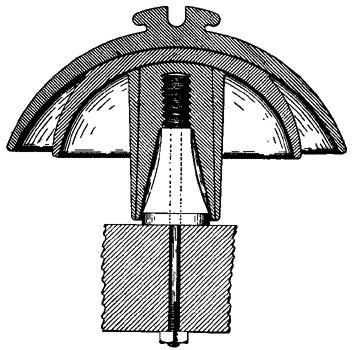[Trade Journal]
Publication: American Electrician
New York, NY, United States
vol. 10, no. 7, p. 349, col. 1-2
NEW
Apparatus
AND
Appliances.
·
·
HIGH VOLTAGE LINE INSULATOR.
The accompanying engraving is reproduced from a patent granted June 7 of the present year to Fred. M. Locke, Victor, N. Y., and illustrates the principle of the insulator manufactured by the patentee for high voltage work.
 |
| High Voltage Line Insulator. |
In the specification of the patent the inventor states that in passing a current of electricity of high voltage over a wire he has found that the static discharge from the surface of the insulator supporting the wire, or the arcing of the current around the insulator, burns the insulator pin off on a plane with the bottom of the petticoat extending the lowest. He has also found that by providing the insulator with a long central petticoat, which incloses the pin down to a point adjacent to the cross-arm, and by making it small in diameter in proportion to the adjacent petticoats of the insulator above it, this central piece is the most valuable insulating surface of the whole insulator on account of the fact that the area of the surface is so small that but little moisture at most can congregate there.
The object of the inventor therefore consists in so constructing an insulator as to prevent this leakage of the current over the insulator to the support, and thereby obviate the burning off of the pin, and to that end his invention consists in constructing an insulator having its inner petticoat extending down to a point adjacent to the cross-arms upon which the pin is mounted, to serve as a protecting sleeve for the pin and increase the arcing distance of the current around the insulator.
The insulator as shown consists of an outer shell, an inner shell and a central petticoat so elongated as to form a protecting sleeve for the insulating pin. This central piece may be constructed in two parts, as shown, and the pin itself be surrounded by a porcelain case, as also shown. The different parts of the insulator are secured together by coating them with a layer of glaze and then baked.
·
·
